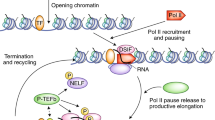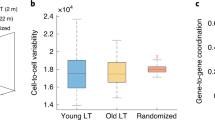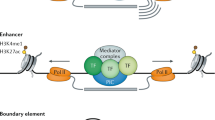Abstract
We report here the transcriptional profiling of the cell cycle on a genome-wide scale in human fibroblasts. We identified approximately 700 genes that display transcriptional fluctuation with a periodicity consistent with that of the cell cycle. Systematic analysis of these genes revealed functional organization within groups of coregulated transcripts. A diverse set of cytoskeletal reorganization genes exhibit cell-cycle–dependent regulation, indicating that biological pathways are redirected for the execution of cell division. Many genes involved in cell motility and remodeling of the extracellular matrix are expressed predominantly in M phase, indicating a mechanism for balancing proliferative and invasive cellular behavior. Transcripts upregulated during S phase displayed extensive overlap with genes induced by DNA damage; cell-cycle–regulated transcripts may therefore constitute coherent programs used in response to external stimuli. Our data also provide clues to biological function for hundreds of previously uncharacterized human genes.
This is a preview of subscription content, access via your institution
Access options
Subscribe to this journal
Receive 12 print issues and online access
$209.00 per year
only $17.42 per issue
Buy this article
- Purchase on Springer Link
- Instant access to full article PDF
Prices may be subject to local taxes which are calculated during checkout



Similar content being viewed by others
References
Nicklas, R.B. How cells get the right chromosomes. Science 275, 632–637 (1997).
Nasmyth, K. Viewpoint: putting the cell cycle in order. Science 274, 1643–1645 (1996).
Stillman, B. Cell cycle control of DNA replication. Science 274, 1659–1664 (1996).
Sanchez, I. & Dynlacht, B.D. Transcriptional control of the cell cycle. Curr. Opin. Cell Biol. 8, 318–324 (1996).
Dyson, N. The regulation of E2F by pRB-family proteins. Genes Dev. 12, 2245–2262 (1998).
Friend, S.H. et al. A human DNA segment with properties of the gene that predisposes to retinoblastoma and osteosarcoma. Nature 323, 643–646 (1986).
Cho, R.J. et al. A genome-wide transcriptional analysis of the mitotic cell cycle. Mol. Cell 2, 65–73 (1998).
Spellman, P.T. et al. Comprehensive identification of cell cycle-regulated genes of the yeast Saccharomyces cerevisiae by microarray hybridization. Mol. Biol. Cell 9, 3273–3297 (1998).
Rao, P.N. & Johnson, R.T. Mammalian cell fusion: studies on the regulation of DNA synthesis and mitosis. Nature 225, 159–164 (1970).
Lockhart, D.J. et al. Expression monitoring by hybridization to high-density oligonucleotide arrays. Nature Biotechnol. 14, 1675–1680 (1996).
Chu, S. et al. The transcriptional program of sporulation in budding yeast. Science 282, 699–705 (1998); erratum: 282, 1421 (1998).
Iyer, V.R. et al. The transcriptional program in the response of human fibroblasts to serum. Science 283, 83–87 (1999).
Tavazoie, S., Hughes, J.D., Campbell, M.J., Cho, R.J. & Church, G.M. Systematic determination of genetic network architecture. Nature Genet. 22, 281–285 (1999).
Chan, G.K., Schaar, B.T. & Yen, T.J. Characterization of the kinetochore binding domain of CENP-E reveals interactions with the kinetochore proteins CENP-F and hBUBR1. J. Cell Biol. 143, 49–63 (1998).
Schaar, B.T., Chan, G.K., Maddox, P., Salmon, E.D. & Yen, T.J. CENP-E function at kinetochores is essential for chromosome alignment. J. Cell Biol. 139, 1373–1382 (1997).
Liu, K. et al. Reversible tumorigenesis induced by deficiency of vasodilator-stimulated phosphoprotein. Mol. Cell. Biol. 19, 3696–3703 (1999).
Kosaki, R., Watanabe, K. & Yamaguchi, Y. Overproduction of hyaluronan by expression of the hyaluronan synthase Has2 enhances anchorage-independent growth and tumorigenicity. Cancer Res. 59, 1141–1145 (1999).
Entwistle, J., Hall, C.L. & Turley, E.A. HA receptors: regulators of signalling to the cytoskeleton. J. Cell. Biochem. 61, 569–577 (1996).
Nguyen, D.H., Hussaini, I.M. & Gonias, S.L. Binding of urokinase-type plasminogen activator to its receptor in MCF-7 cells activates extracellular signal-regulated kinase 1 and 2 which is required for increased cellular motility. J. Biol. Chem. 273, 8502–8507 (1998).
Feng, H. et al. CUL-2 is required for the G1-to-S-phase transition and mitotic chromosome condensation in Caenorhabditis elegans. Nature Cell Biol. 1, 486–492 (1999).
Wang, X.W. et al. GADD45 induction of a G2/M cell cycle checkpoint. Proc. Natl. Acad. Sci. USA 96, 3706–3711 (1999).
Harkin, D.P. et al. Induction of GADD45 and JNK/SAPK-dependent apoptosis following inducible expression of BRCA1. Cell 97, 575–586 (1999).
Moorman, J.P., Bobak, D.A. & Hahn, C.S. Inactivation of the small GTP binding protein Rho induces multinucleate cell formation and apoptosis in murine T lymphoma EL4. J. Immunol. 156, 4146–4153 (1996).
O'Connell, C.B., Wheatley, S.P., Ahmed, S. & Wang, Y.L. The small GTP-binding protein rho regulates cortical activities in cultured cells during division. J. Cell Biol. 144, 305–313 (1999).
Madaule, P. et al. Role of citron kinase as a target of the small GTPase Rho in cytokinesis. Nature 394, 491–494 (1998).
Guasch, R.M., Scambler, P., Jones, G.E. & Ridley, A.J. RhoE regulates actin cytoskeleton organization and cell migration. Mol. Cell. Biol. 18, 4761–4771 (1998).
Vallenius, T., Luukko, K. & Makela, T.P. CLP-36 PDZ-LIM protein associates with nonmuscle α-actinin-1 and α-actinin-4. J. Biol. Chem. 275, 11100–11105 (2000).
Sato, N., Funayama, N., Nagafuchi, A., Yonemura, S. & Tsukita, S. A gene family consisting of ezrin, radixin and moesin. Its specific localization at actin filament/plasma membrane association sites. J. Cell Sci. 103, 131–143 (1992).
Radhakrishna, H., Al-Awar, O., Khachikian, Z. & Donaldson, J.G. ARF6 requirement for Rac ruffling suggests a role for membrane trafficking in cortical actin rearrangements. J. Cell Sci. 112, 855–866 (1999).
Kondo, A. et al. A new paxillin-binding protein, PAG3/Papα/KIAA0400, bearing an ADP-ribosylation factor GTPase-activating protein activity, is involved in paxillin recruitment to focal adhesions and cell migration. Mol. Biol. Cell 11, 1315–1327 (2000).
Law, S.F., O'Neill, G.M., Fashena, S.J., Einarson, M.B. & Golemis, E.A. The docking protein HEF1 is an apoptotic mediator at focal adhesion sites. Mol. Cell. Biol. 20, 5184–5195 (2000).
Leeuwen, F.N. et al. The guanine nucleotide exchange factor Tiam1 affects neuronal morphology; opposing roles for the small GTPases Rac and Rho. J. Cell Biol. 139, 797–807 (1997).
Arai, M. & Kwiatkowski, D.J. Differential developmentally regulated expression of gelsolin family members in the mouse. Dev. Dyn. 215, 297–307 (1999).
North, A.J. et al. Molecular map of the desmosomal plaque. J. Cell Sci. 112, 4325–4336 (1999).
Assmann, V., Jenkinson, D., Marshall, J.F. & Hart, I.R. The intracellular hyaluronan receptor RHAMM/IHABP interacts with microtubules and actin filaments. J. Cell Sci. 112, 3943–3954 (1999).
Bachmann, C., Fischer, L., Walter, U. & Reinhard, M. The EVH2 domain of the vasodilator-stimulated phosphoprotein mediates tetramerization, F-actin binding, and actin bundle formation. J. Biol. Chem. 274, 23549–23557 (1999).
Wei, M.C. et al. tBID, a membrane-targeted death ligand, oligomerizes BAK to release cytochrome c. Genes Dev. 14, 2060–2071 (2000).
Yamamoto, K., Ichijo, H. & Korsmeyer, S.J. BCL-2 is phosphorylated and inactivated by an ASK1/Jun N-terminal protein kinase pathway normally activated at G(2)/M. Mol. Cell. Biol. 19, 8469–8478 (1999).
Phillips, A.C., Ernst, M.K., Bates, S., Rice, N.R. & Vousden, K.H. E2F-1 potentiates cell death by blocking antiapoptotic signaling pathways. Mol. Cell 4, 771–781 (1999).
Hakem, A., Sasaki, T., Kozieradzki, I. & Penninger, J.M. The cyclin-dependent kinase Cdk2 regulates thymocyte apoptosis. J. Exp. Med. 189, 957–968 (1999).
Gil-Gomez, G., Berns, A. & Brady, H.J. A link between cell cycle and cell death: Bax and Bcl-2 modulate Cdk2 activation during thymocyte apoptosis. EMBO J. 17, 7209–7218 (1998).
Lind, E.F. et al. Bcl-2-induced changes in E2F regulatory complexes reveal the potential for integrated cell cycle and cell death functions. J. Immunol. 162, 5374–5379 (1999).
Ross-Macdonald, P. et al. Large-scale analysis of the yeast genome by transposon tagging and gene disruption. Nature 402, 413–418 (1999).
McNally, F.J. & Thomas, S. Katanin is responsible for the M-phase microtubule-severing activity in Xenopus eggs. Mol. Biol. Cell 9, 1847–1861 (1998).
Hartman, J.J. et al. Katanin, a microtubule-severing protein, is a novel AAA ATPase that targets to the centrosome using a WD40-containing subunit. Cell 93, 277–287 (1998).
Farrance, I.K. & Ordahl, C.P. The role of transcription enhancer factor-1 (TEF-1) related proteins in the formation of M-CAT binding complexes in muscle and non-muscle tissues. J. Biol. Chem. 271, 8266–8274 (1996).
Stewart, A.F., Suzow, J., Kubota, T., Ueyama, T. & Chen, H.H. Transcription factor RTEF-1 mediates α1-adrenergic reactivation of the fetal gene program in cardiac myocytes. Circ. Res. 83, 43–49 (1998).
Lee, S.B. et al. The Wilms tumor suppressor WT1 encodes a transcriptional activator of amphiregulin. Cell 98, 663–673 (1999).
White, K.P., Rifkin, S.A., Hurban, P. & Hogness, D.S. Microarray analysis of Drosophila development during metamorphosis. Science 286, 2179–2184 (1999).
Martin, L.G., Demers, G.W. & Galloway, D.A. Disruption of the G1/S transition in human papillomavirus type 16 E7-expressing human cells is associated with altered regulation of cyclin E. J. Virol. 72, 975–985 (1998).
Tomayo, P. et al. Interpreting patterns of gene expression with self-organizing maps: methods and application to hematopoietic differentiation. Proc. Natl. Acad. Sci. USA 96, 2907–2912 (1999).
Acknowledgements
We thank D. Galloway for providing the cell line; L. Wodicka for help with experiments; M. Ho for help with data analysis; M. Mittmann and D. Balaban for array design; Affymetrix Product Development for array testing and validation; F.F. Cai for help in construction of the human functional database; and M. Mindrinos, S. Chang, C. Chon, J. Yang and N. Thayer for discussions and a critical reading of the manuscript. This work was supported in part by NIH grants to S.J.E. and R.W.D.
Author information
Authors and Affiliations
Corresponding author
Rights and permissions
About this article
Cite this article
Cho, R., Huang, M., Campbell, M. et al. Transcriptional regulation and function during the human cell cycle. Nat Genet 27, 48–54 (2001). https://doi.org/10.1038/83751
Received:
Accepted:
Issue Date:
DOI: https://doi.org/10.1038/83751
This article is cited by
-
Cyclical regression covariates remove the major confounding effect of cyclical developmental gene expression with strain-specific drug response in the malaria parasite Plasmodium falciparum
BMC Genomics (2022)
-
SMOC2 promotes aggressive behavior of fibroblast-like synoviocytes in rheumatoid arthritis through transcriptional and post-transcriptional regulating MYO1C
Cell Death & Disease (2022)
-
Benchmarking tools for detecting longitudinal differential expression in proteomics data allows establishing a robust reproducibility optimization regression approach
Nature Communications (2022)
-
Current Advances in Aptamer-based Biomolecular Recognition and Biological Process Regulation
Chemical Research in Chinese Universities (2022)
-
Comparative physiological and full-length transcriptome analyses reveal the molecular mechanism of melatonin-mediated salt tolerance in okra (Abelmoschus esculentus L.)
BMC Plant Biology (2021)



